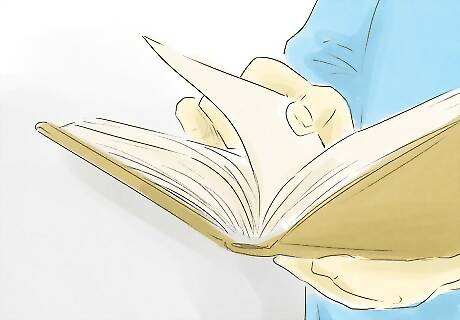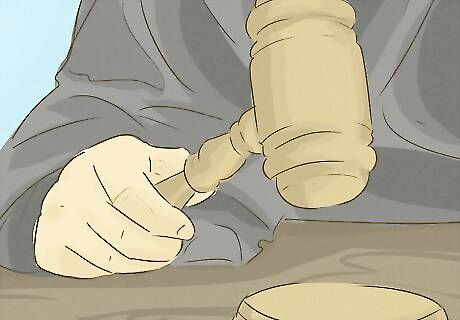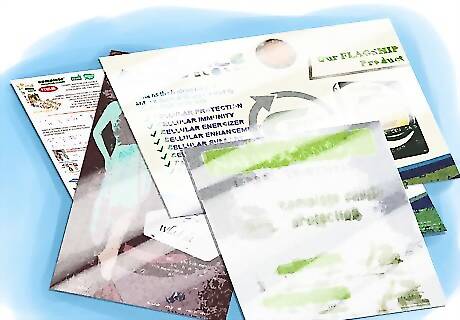
views
X
Trustworthy Source
Reporters Committee for Freedom of the Press
Nonprofit legal organization dedicated to protecting First Amendment rights to American citizens
Go to source
For example, if you write a newspaper article about people who do not pay their taxes and use a picture of your neighbor, then you create the false impression that your neighbor is a tax cheat. To defend against a false light claim, you should try to prove that the statement is true. Also, you will need to seek the assistance of a lawyer who can help you come up with other defenses.
Building Your Defense

Distinguish “false light” from defamation. In a defamation lawsuit, the plaintiff alleges that you defamed them by publishing information that is false. In a false light claim, however, the information does not need to be false. Rather, the information (even if true) can be presented in such a way that it creates a false impression. For example, it is probably defamation to state falsely that a person murdered her mother. However, it is not defamation to state that someone was arrested for murdering her mother if that fact is true. Nevertheless, you could be liable for “false light” if you state that someone was arrested for murdering her mother but do not then clarify that the police later exonerated her. Here, the statement that someone has been arrested may, in fact, be true. However, it has created a misleading (and highly offensive) impression in the reader’s mind. To complicate matters, in some states the challenged statements must actually be false. In those states, even a false impression will not give rise to a “false light” claim unless the challenged statement is actually false.

Understand the elements of a false light claim. The elements a plaintiff must prove will differ depending on the state law. However, the plaintiff must generally prove the following elements: you published information widely you identified the plaintiff in the publication you placed the plaintiff in a “false light” which would be highly offensive to a reasonable person that you were at “fault” for creating the false impression, either because you knew the information was false or were reckless in your disregard for the impression created (if publishing information about a public figure) or because you were negligent (when publishing information about a private person)

Identify the offending statement or imagery. After filing a lawsuit, the plaintiff should send you a copy of the complaint. This document contains the allegations surrounding the lawsuit. Read the complaint to find out what statements or image the plaintiff believes casts them in a false light. If the plaintiff has not yet brought a lawsuit, then you might receive a “cease and desist” letter. This letter should also tell you what information is casting the person in a false light.

Read your state law. To understand your defenses, you need to first understand your state’s law. False light is a state law claim, and each state’s law varies. For example, some states require that the offending statement be false. In other states, a plaintiff can sue for a true statement so long as the statement creates an offensive false impression. To find your state law, visit your local law library, which should be in your local courthouse. Ask the librarian to see the statute on false light. You can also visit the Digital Media Law Project, which has summaries of the law for several states.

Gather evidence that the statement is truthful. In many states, truth is a complete defense to a false light claim. This is not true in all states. Nevertheless, your defense will be stronger if the statement is true regardless of what state you are sued in. Accordingly, you should focus on getting proof that the statement is true. If you based the statement on an observation, then look for any notes you took at the same time as you observed the event you wrote about. If you relied on witness testimony, then carefully review your notes. How do you know that the witness is credible? Were there any red flags that the witness might have been lying? Was the information based on something the plaintiff told you? Do you have emails or phone messages containing the statement?

Check whether the statement was widely distributed. A statement must be distributed widely in order to support a false light claim. You can defeat this type of claim if you can show that you only told one or two people. If you posted something on your blog or website, keep track of how many people have visited the site since the information was published. If no one visited your blog (other than the plaintiff), then you have proof that the information was not widely distributed. If you distributed information using email, count the number of people who received the email. Of course, even if you told only a few people, they might in turn tell others. In this way, the information can be widely distributed. Nevertheless, the fewer people told the better your defense.

Meet with a lawyer. To understand how to build a strong defense, you should meet with a qualified attorney. A lawyer will listen to your situation and advise you on your best defenses. To find a qualified attorney, you should visit your state’s bar association. It should run a referral program. If you are a reporter, then you can contact the Reporters Committee for Freedom of the Press, which has a legal defense hotline available 24 hours a day, seven days a week. You can call 1-800-336-4243.

Get admissions from the plaintiff during a deposition. After a lawsuit starts, you will be able to engage in a fact-finding phase called “discovery.” During discovery, each party can ask questions (written or orally) of each other. In a deposition, you or your lawyer will ask questions in person, which the plaintiff must answer under oath. You should try to get the plaintiff to admit that he or she was not really offended by the false impression created by your statements. Technically, the plaintiff only needs to prove that the statement would be highly offensive to a “reasonable person.” Nevertheless, the amount of damages you might have to pay will be much lower if the plaintiff essentially admits that they were not personally offended by the false impression.
Defending Yourself in Court

Raise affirmative defenses in your answer. After receiving the complaint, you should read it and then talk with your attorney about what defenses you want to raise in your answer. There are several affirmative defenses you can raise, though these may depend on your state law: The statement or information is truthful. In a state that requires that the statement be false, then you can raise truthfulness as a defense. The offending statement is opinion. A false impression must be created about a fact. Accordingly, if you published opinion, then you are protected. The offending information was parody. Similarly, parody is not factual. You will have a defense if the average reader would understand the statement as parody.

Bring a motion for summary judgment. You can defeat the lawsuit and avoid going to trial by filing a motion for summary judgment after the close of discovery. In a summary judgment motion, you argue that there are no issues of material fact in dispute and that you are entitled to judgment as a matter of law. For example, if you can prove that the statement is true, then you can get summary judgment (in a state where truth is a complete defense). Also, you might be able to argue that the false impression was not “highly offensive.” For example, a similar case might have been decided by your state’s Supreme Court, which held that impression of the sort you made are not objectively offensive. In this situation, you could also win on summary judgment. You should have your lawyer draft the motion for summary judgment. It is a technical document that requires extensive knowledge of state law.

Gather information about your fact-checking. If you do not win on summary judgment, you will have to go to trial. At trial, you will need to defend your journalistic practices. Specifically, you need to show that you were not “at fault” for publishing the information. You can show you were not reckless or negligent in publishing the information by recreating how you checked the accuracy of the information you published. Did you have several independent sources for the information? Did you rely on official government reports? Did you use a trusted source? You will need to show the court your notes, copies, and drafts of source material. You should find and preserve this information.

Attend trial. At trial, you and the plaintiff will present your case to the judge or jury. The trial will consist of an opening statement, the presentation of evidence and witnesses, and then a closing statement. As the defendant, you will go second. For more information on the trial process, see Represent Yourself in Court (U.S.).
Avoiding Problems in the Future

Pay attention to “red flag” statements. Some statements are so offensive that you risk liability whenever you make them. For this reason, you should be particularly careful when making the following assertions: someone has engaged in immoral behavior someone has committed a crime or been arrested a person has committed professional malpractice or incompetence a person has behaved in a sexually inappropriate manner a business has behaved unethically you criticize a business’s products or services

Fact check your articles. In states where false light claims require that the statement be false, you can save yourself a false light lawsuit by making sure that statements are true. Use reliable sources, citing to official government reports wherever you can. Also document your research. Because the plaintiff must show that you were reckless or negligent in publishing the information, you can defend yourself by keeping a log of your fact-checking. Photocopy or print off information that you use and preserve it.

Request comment from the subject. Before hitting the “publish” button on your story about someone, reach out to the subject of the story for comment. You might find out that your sources were wrong or that there is an innocent explanation for what the person did. Getting this information ahead of time can help limit your exposure to a lawsuit. You should also seek consent, where possible. A person can consent expressly by signing a waiver form, or impliedly, by seeing a draft of your story and not objecting. You should try to get express consent, where possible.

Pay attention to illustrations. You can create false impressions through visual images. You want to be careful about how you illustrate your stories, especially when writing about “red flag” issues such as criminality or bad business practices. Slapping a picture of McDonald’s onto a generic story about corporate greed can create a false impression that McDonald’s has engaged in business impropriety. You can use stock photographs, if you need to. The models in these stock photos often sign waivers which permit their use in newspaper stories.

Step back and assess the article as a whole. You should always keep in mind what a false light claim is: an offensive false impression created in the reader’s mind about the subject. Accordingly, you should step back and look over your article or story. Ask yourself whether you are inadvertently creating a false impression about the subject. If you are unsure, then share your story with someone else and ask what they think of the person you have written about. If the reader has very negative impressions which are false, then you should clarify the story.



















Comments
0 comment